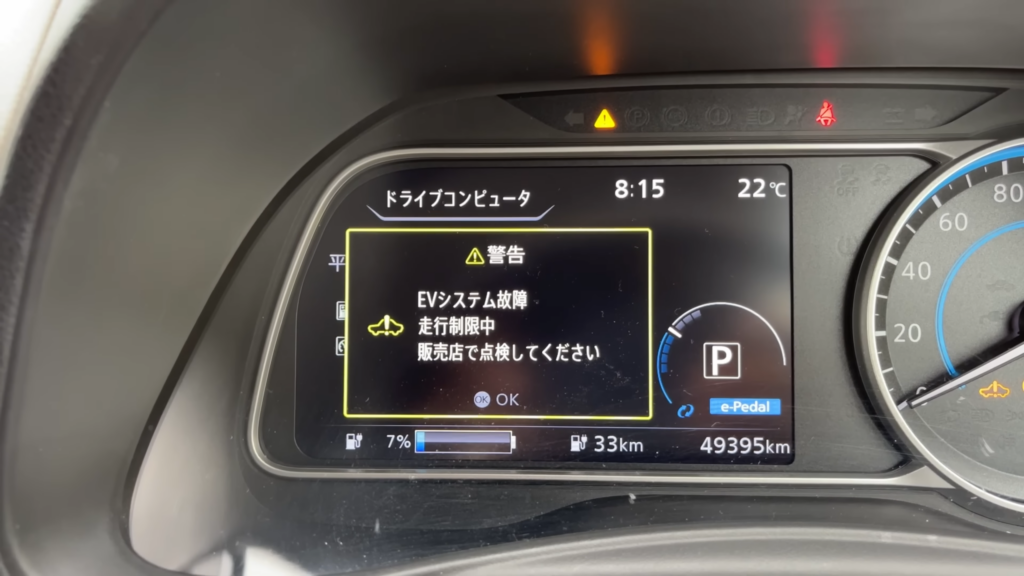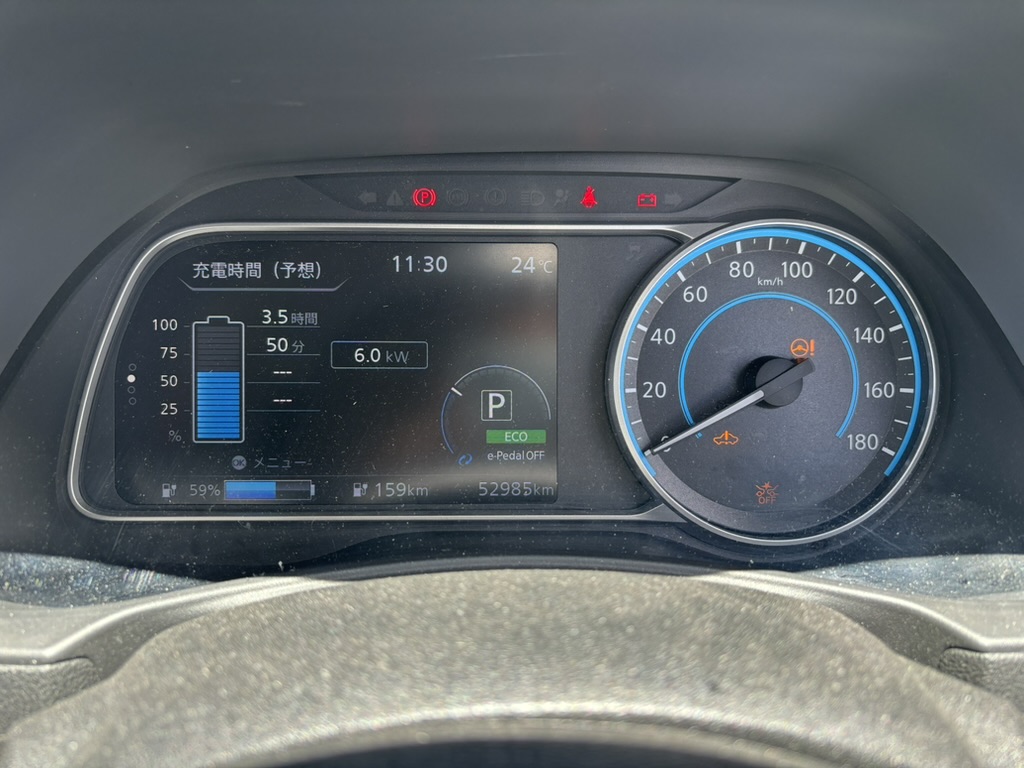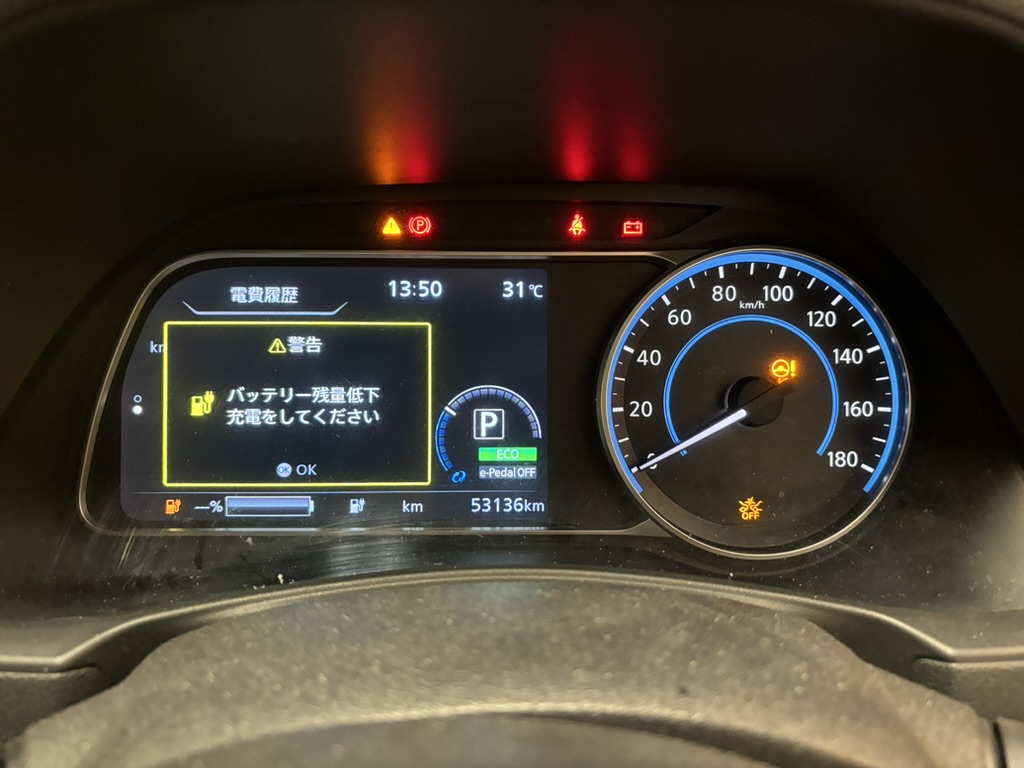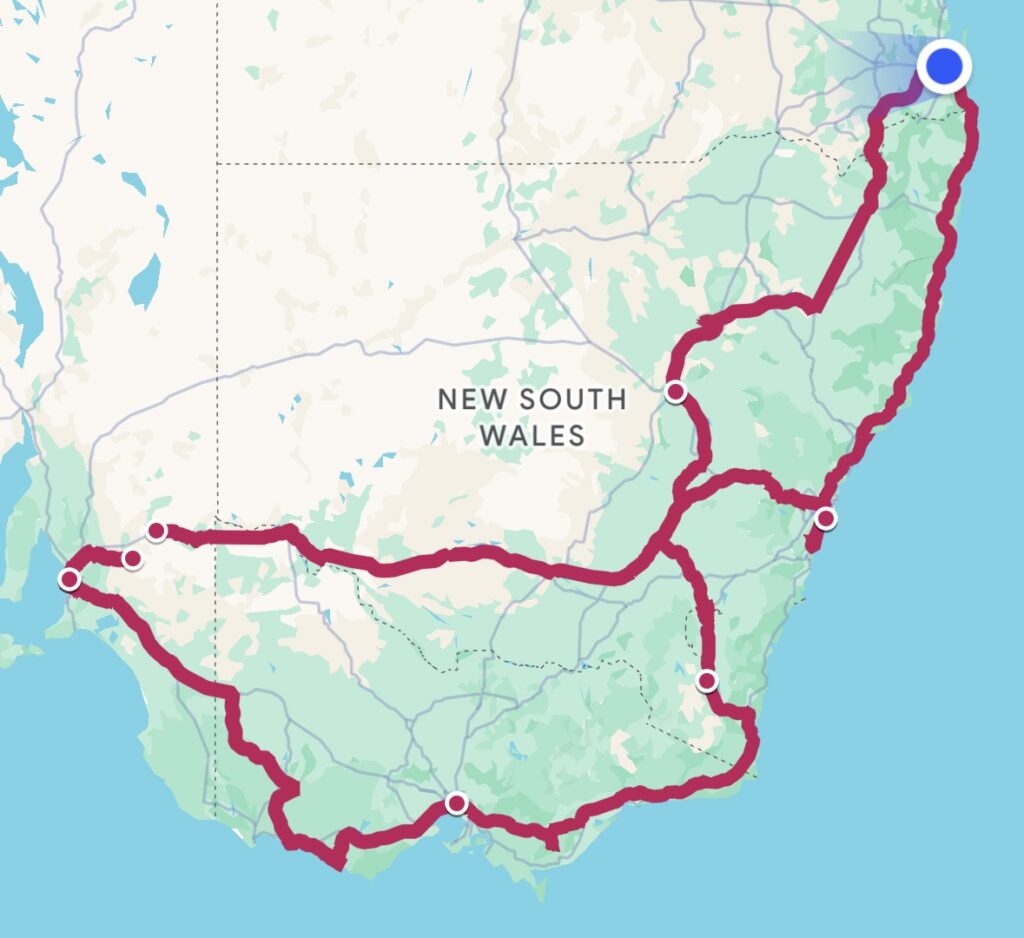This blog post is part of a series about my road trip around South/East Australia in an electric vehicle. Read other posts using the same tag.
Day 20 continued: Brisbane or tow truck?
So to recap from the last post – this is basically what I saw:

⚠ 警告
EVシステム故障
走行制限中
販売店で点検してください
⚠ Warning
EV system fault
Operation restricted
Return to dealer for inspection
Hmm. Not good.
An adrenalin rush was the last thing I needed on an increasingly hot Queensland summer’s day as I started to get a fluttering heart and clammy hands. I went back and forth plugging and unplugging to see what would happen. This went on for what felt like an eternity. The interesting part is that the warning would sometimes appear and other times clear itself, which suggested it was transient, but the reason why wasn’t clear.
One of the guys taking care of the fast charger repair made a light joke about where the dealer was in Japan, and how far it would be to get the car back there. As weird as it might sound – I honestly appreciated that, as it diffused some of the stress you can probably imagine I was having.
Owen popped back to check on what was going on, and suggested we could have a look at the fuses. Popped open the bonnet and jiggled some fuses, but no dice.
What to do?
I had ascertained that the car had power for traction – at least I could drive it around. But apart from that, I had 59% charge to go on, with a dodgy estimated range of 159km. Google Maps indicated if I was to return home it would be a 153km direct journey. At this point I was willing to abandon any remaining bits of my trip and go somewhere where I can deal with car issues without screwing things up more.

“Do I dare make it all the way home?” I asked myself.
After flicking through my notes to see what Plan Zs I could find, the answer was: “Yes.”
I did think about potentially stopping at chargers along the way, but that’ll potentially chew up more of the remaining battery to divert myself to a station, to possibly end up not charging. I’d rather risk going flat getting as close to home than detouring and potentially get towed at a lower cost from wherever I might end up compared to getting towed from Warwick to Brisbane.
I powered up my car and took some deep breaths. I’d need to use all the tricks I know to hypermile this car home. Slower, smooth driving. Keeping the car in motion with as little braking (even regenerative) as possible. No A/C. Windows up.
The possibility of having a flat EV on a highway was scary enough, but add to that no air conditioning in a stuffy cabin on a hot summer’s day… I was sweating like there was no tomorrow from stress and the heat.
After two hours of the world’s most stressful drive – I slipped into my garage with this on the dash:

A remaining charge of ---% and warnings telling me to recharge immediately. I had made it back by the skin of my teeth.1
Phew. After my heart rate settled, the warm and fuzzy sense of accomplishment finally kicked in looking back the ~6400km covered over three weeks on the road:

Reflections
EV range anxiety and using a Leaf for long trips
Having a car with ~200-240km range is workable even for road trips as long as you have enough infrastructure around it. The network I covered in eastern Australia had fast charging along most popular routes, generally at intervals of 200km or less.
The reason why ICE cars work well is that we have places to refuel them in lots of places along most routes that can be depended upon in time of need, and the same will apply when EVs become more popular and charging stations more widespread and reliable. And it’s not like ICE car drivers don’t need to consider fuel accessibility in remote areas either:

I’ve shown that the range of the 40kWh Leaf was able to sustain a fairly long road trip, though only just. It meant that I basically needed to stop when travelling for two hours, which was perfectly timed for keeping me refreshed with regular breaks – doubly important since I was driving solo. There’s also the need to monitor battery temperatures to see if you’ll be held back for half an hour here and there to cool off.
If you’re pragmatic, you could also spin these deficiencies as a way to force yourself to stop and actually take in the various places dotted along the way for a slower road trip, rather than just barrelling through them.
But for most people – and this is already common knowledge – the Nissan Leaf in its current design is not suitable for long continuous travel. My usual use for the Leaf remains as a commuter/city car – my previous infrequent commute to the Gold Coast is only ~130km round-trip, which means I can charge at home and not worry about public charging.
Carry plans, and some luck for good measure
Another negative of using a Leaf for this road trip was that I had to spend an inordinate amount of time planning beforehand. Identifying charging stations is relatively straightforward now with apps like PlugShare and ABRP; it was more that I had to think through possible Plan Bs, Cs and Zs in case something went wrong, mainly because of reliability concerns (would the charger work when I get there?), choice of plug (CHAdeMO chargers are massively outnumbered by CCS ones), and time constraints (accommodation was pre-booked.)
ABRP was surprisingly good at reflecting real world usage probably because they collect consumption data, so I would definitely recommend it for running numbers on range, but you probably shouldn’t cut it too fine (like I did at times) because there are things like headwinds that can considerably change fortunes.
That said, I was lucky that I made it to all the stops I needed to make through this road trip with minimal delays. On top of that, I was even more lucky to have had CHAdeMO fast charging working at almost every point I needed it, even in more remote areas. For the two or three places where I couldn’t charge as intended – it still worked out with those Plan Bs and quick thinking.
Was it worth going electric for this trip?
The total cost of the trip came to $387.55 Australian Dollars (excluding discounts) for 6379 kilometres, or roughly $6 per 100km of primarily highway driving.
So cost-wise, taking the Leaf on this particular long journey was definitely cheaper than petrol vehicles, which I would have estimated at around $9 per 100km2. I would note that most of the “free” chargers I encountered would or should have been paid charging, so the EV cost will likely go up a bit.
As of writing this last post in the series, it’s been a year since I did this trip and prices for public charging have gone up significantly with the recent bout of inflation, so the gap between petrol and electric has tightened up by 2025. I expect electric to maintain an edge on cost going forward, but only a marginal one, for long distance travel here in Australia.
(As an aside, for my usual use of the Leaf, I currently have a electricity plan at home that gives me two hours of free power per day – enough for my trickle charger to top my car up – so my running costs right now are almost nil.)
Wrapping up
The solo road trip itself was quite the experience, as I hadn’t done anything like it before (EV or otherwise.) Getting out there to see different parts of Australia just as I was about to becoming a citizen, I got to talk to quite a wide cross section of people here, which was the unexpected highlight out of all of this. Probably something I’d do next time would be to take more photos with people I meet and capture their stories (with permission of course) – I was too engrossed in discussions this time to remember to do that.
Even though this blog series has been a mostly positive celebration of the potential of a Nissan Leaf, would I do this again? Probably not. If I had another EV? Maybe, but there’s already plenty of people who have done a full circle of Australia in their EVs so it wouldn’t be blog-worthy then3.
I cannot understate the sheer amount of luck I had on this trip, because I don’t think I’d be able to achieve another long road trip with this Leaf that’s gone as smoothly as this one with the state of charging infrastructure as it is right now. I’ve gone back and looked at some of the chargers I used that did work at the time of my trip, and from the comments on PlugShare reliability at some is spotty. One faulty station is all it takes to derail a road trip of this length; it’s still a risky proposition, though this is improving over time.
As for the car after all this? Weirdly, it was fine to accept a charge from my home charger after I gave it some rest. Hasn’t hit any issues since. It could be that is just needed a reset, or it could be a weak 12v battery; I did get the frequently recommended LeafSpy app with an OBD reader afterwards, but didn’t find anything of note, so… 🤷.
P.S. I also did eventually go and visit Toowoomba half a year after this road trip. Won’t be blogging about that though.
- Technically I didn’t run it into reserve power, as the lack of “turtle mode” on the dash indicates – that would have given me a little more range but driving a kneecapped car on a highway is not something I would have wanted to contend with. ↩︎
- Estimated using 91 unleaded pricing around 2024, at $1.80/L with a car running at 5L/100km consumption. ↩︎
- Not that I did this blog series to brag. Honest! ↩︎